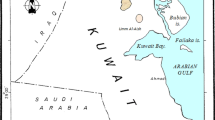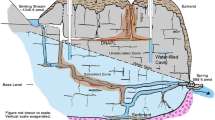Abstract
Published information on the correlation and field-testing of the technique of stack-unit/aquifer sensitivity mapping with documented subsurface contaminant plumes is rare. The inherent characteristic of stack-unit mapping, which makes it a superior technique to other analyses that amalgamate data, is the ability to deconstruct the sensitivity analysis on a unit-by-unit basis. An aquifer sensitivity map, delineating the relative sensitivity of the Crouch Branch aquifer of the Administrative/Manufacturing Area (A/M) at the Savannah River Site (SRS) in South Carolina, USA, incorporates six hydrostratigraphic units, surface soil units, and relevant hydrologic data. When this sensitivity map is compared with the distribution of the contaminant tetrachloroethylene (PCE), PCE is present within the Crouch Branch aquifer within an area classified as highly sensitive, even though the PCE was primarily released on the ground surface within areas classified with low aquifer sensitivity. This phenomenon is explained through analysis of the aquifer sensitivity map, the groundwater potentiometric surface maps, and the plume distributions within the area on a unit-by- unit basis. The results of this correlation show how the paths of the PCE plume are influenced by both the geology and the groundwater flow.
Résumé
Rares sont les informations publiées sur des corrélations et validations concrètes de la technique de cartographie par unités composites (“stack-unit”) de la sensibilité des aquifères avec les panaches souterrains de contaminants renseignés. La caractéristique propre qui fait de la cartographie par unités composites une technique supérieure aux autres, qui agrègent simplement les données, est la possibilité de décomposer unité par unité l’analyse de sensibilité. Une carte de sensibilité, délimitant la sensibilité relative de l’aquifère de Crouch Branch sur la Zone Administration/Production (A/M) du Savannah River Site (SRS) en Caroline du Sud (Etats-Unis), comprend six unités hydrostratigraphiques, des unités de sol, et des données hydrologiques pertinentes. La comparaison entre cette carte de sensibilité et la distribution du contaminant tétrachloroéthylène (PCE) fait apparaître la présence de PCE dans l’aquifère de Crouch Branch, dans un secteur classé comme hautement sensible. Pourtant, le PCE avait été originellement rejeté en surface dans des zones où l’aquifère est classé comme peu sensible. Ce phénomène peut s’expliquer en analysant unité par unité la carte de sensibilité de l’aquifère, les cartes piézométriques, et les distributions des panaches sur le secteur. Les résultats de la corrélation montrent comment les cheminements des panaches sont influencés à la fois par la géologie et par les écoulements souterrains.
Resumen
Es rara la información publicada sobre la correlación y pruebas de campo de la técnica de unidad de apilamiento/cartografía de sensibilidad acuífera con plumas contaminantes subsuperficiales documentadas. La característica inherente de la cartografía de la unidad de apilamiento, que la hace una técnica superior a otros análisis que amalgaman los datos, es la habilidad para deconstruir el análisis de sensibilidad con base en la unidad-por-unidad. Un mapa de sensibilidad del acuífero, delineando la sensibilidad relativa del acuífero Crouch Branco, del área Administrativo/Industrial (A/I) en el Sitio del Río Savannah (SRS) en Carolina del Sur, EE.UU., incorpora seis unidades hidrostratigráficas, unidades de suelo superficial, y datos hidrológicos pertinentes. Cuando este mapa de sensibilidad se compara con la distribución del contaminante tetracloroetileno (PCE), el PCE está presente dentro del acuífero Crouch Branch, dentro de una área clasificada como muy sensible, aunque el PCE se liberó principalmente en la superficie del terreno, dentro de áreas clasificadas como de sensibilidad acuífera baja. Este fenómeno se explica a través del análisis del mapa de sensibilidad del acuífero, los mapas de la superficie potenciométrica del agua subterránea, y las distribuciones de la pluma dentro del área, con base en la unidad-por-unidad. Los resultados de esta correlación muestran cómo los caminos de la pluma de PCE, están influenciados tanto por la geología como por el flujo de agua subterránea.













Similar content being viewed by others
References
Aadland RK (1996) Geology of the A/M Area, Savannah River Site (U). Westinghouse Savannah River Co., Report WSRC-RP-96-505
Aadland RK, Gelici JA, Thayer PA (1995) Hydrogeologic framework of west-central South Carolina. Water Resources Division Report 5, State of South Carolina Department of Natural Resources, Columbia, SC
Berg RC (2001) Aquifer sensitivity classification for Illinois using depth to uppermost aquifer material and aquifer thickness. Illinois State Geol Surv Circ 560
Berg RC, Greenpool MR (1993) Stack-unit geologic mapping: color-coded and computer-based methodology. Illinois State Geol Surv Circ 552
Berg RC, Kempton JP, Stecyk AN (1984) Geology for planning in Boone and Winnebago Counties. Illinois State Geol Surv Circ 531
Colquhoun DJ, Woolen ID, Van Niewenhuise DS, Padgett GG, Oldham RW, Boylan DC, Bishop JW, Howell PD (1983) Surface and subsurface stratigraphy, structure and aquifers of the South Carolina Coastal Plain. Dept. of Geology, University of South Carolina, Columbia, SC
Environmental Systems Research Institute (ESRI) (1993) Understanding GIS: the ARC/INFO method. Wiley, New York, NY
Fleming AH (1994) The hydrogeology of Allen county, Indiana: A geologic and ground-water atlas. Indiana Geological Survey Special Report 57, Indiana Geological Survey, Bloomington, IN
Harris, MK, Looney BB, Jackson DG (2004) Geology and environmental remediation: Savannah River Site, South Carolina. Environ Geosci 11(4):191–204
Holman IP, Palmer RC (1998) Introducing multidisciplinary groundwater vulnerability mapping to the Philippines: a case study from Cebu City. J Geol Soc Philippines 53(3–4):158–179
Holman IP, Palmer RC (1999) Groundwater protection incorporated into land use planning: a study from Cebu City, the Philippines. In Ellis B (ed) Impacts of urban growth on surface water and groundwater quality. Proc IUGG 99, Symposium HS5. IAHS Publ. No. 259, IAHS, Wallingford, UK, pp 125–132
Holman IP, Palmer RC, Leonaviciute N (2000) Using soil and Quaternary geological information to assess the intrinsic groundwater vulnerability of shallow aquifers: an example from Lithuania. Hydrogeol J 8:636–645
Holman IP, Palmer RC, Bellamy PH, Hollis JM (2005) Validation of an intrinsic groundwater pollution vulnerability methodology using a national nitrate database. Hydrogeol J 13:665–674
Hoyer BE, Hallberg GR (1991) Groundwater vulnerability regions of Iowa. Iowa Geological Survey Bureau Special Map Series II, scale 1:500,000, Iowa Geological Survey, Des Moines, IA
Hutchinson MF (1988) Calculation of hydrologically sound digital elevation models. Proceedings of the Third International Symposium on Spatial Data Handling, 17–19 August 1988, Sydney. International Geographical Union, Columbus, OH, pp 117–133
Jackson DG, Payne TH, Looney, BB, Rossabi J (1996) Estimating the extent and thickness of DNAPL within the A/M Area of the Savannah River Site (U). Westinghouse Savannah River Co. Report WSRC-RP-96-0574, Westinghouse Savannah River Co., Aiken, SC
Keefer DA (1995) Potential for agricultural chemical contamination of aquifers in Illinois. Illinois State Geological Survey Environmental Geology 148, Illinois State Geological Survey, Champaign, Ill
Keefer DA, Berg RC (1990) Potential for aquifer recharge in Illinois. Illinois State Geological Survey Map. Scale 1:1,000,000, Illinois State Geological Survey, Champaign, Ill
Lusch DP, Rader CP, Barrett LR, Radner N (1992) Aquifer vulnerability to surface contamination in Michigan. Center for remote sensing and department of geography. Michigan State University, E. Lansing, MI
Marine IW, Bledsoe HW (1984) Supplemental technical summary M Area groundwater investigation, DPSTD-84-0112, E:I. Du Pont de Nemours, Savannah River Laboratory, Aiken, SC
Palmer RC, Holman IP, Lewis MA (1995) Guide to groundwater vulnerability mapping in England and Wales. HMSO, London
Passero RN, Cohen FJ, Dulaney SJ, McNamara, J, Benton SE (1989) Determining the vulnerability of glacial drift aquifer systems in Michigan. 34th Annual Midwest Groundwater Conference, program with abstracts, 18–20 October 1989, Kalamazoo, MI
Rine JM, Shafer JM, Covington ER, Trudnak JE, Berg RC (1997) Development of a GIS contamination potential map for the tertiary interval within a portion of the Administration/Manufacturing (A/M) Areas, Savannah River Site, South Carolina. Report 97-F124-1, Earth Sciences and Resources Institute, University of South Carolina, Columbia, SC
Rine JM, Berg RC, Shafer JM, Covington ER, Reed JK, Bennett CB, Trudnak JE (1998) Development and testing of contamination potential mapping system for a portion of the General Separations Area, Savannah River Site, South Carolina. Environ Geol 35(4):263–277
Schmidt RR (1987) Groundwater contamination susceptibility in Wisconsin: Wisconsin Department of Natural Resources. Wisconsin’s Groundwater Management Plan Report No. 5. PUBL-WR-177-87, Wisconsin Department of Natural Resources, Madison, WI
Shafer JM (1985) An assessment of groundwater quality and hazardous substance for a statewide monitoring strategy (P.A. 83-1268). Contract Report 367, Illinois State Water Survey, Bloomington, IN
Stuck WM (1980) Soil survey of Beaufort and Jasper Counties, South Carolina. US Department of Agriculture Soil Conservation Service Report, US Department of Agriculture Soil Conservation, Washington, DC
Trent VP (1992) Ground-water pollution susceptibility map of Georgia: GIS-1. Department of Natural resources Environmental Protection Division Georgia Geologic Survey, GIS Data Bases, Atlanta, GA, 6.9 MB
US Environmental Protection Agency (1993) Groundwater resource assessment. EPA 813-R-93-003, US EPA Office of Groundwater and Drinking Water, Washington, DC
Acknowledgements
This project was funded through the South Carolina Universities Research and Education Foundation (SCUREF) Task Order #161 by the Westinghouse Savannah River Company (WSRC). Completion of this phase of Task 161 is the direct result of cooperation between personnel at the Earth Sciences and Resources Institute, University of South Carolina (ESRI-USC) and the researchers at WSRC. SRS technical oversight staff responsible for monitoring task progress and furnishing approved data sets are John Reed and Robert Van Pelt. Particular thanks go to the late Rolf Aadland who furnished updated geologic unit structure maps and who shared many hours discussing the peculiarities of SRS geology.
Author information
Authors and Affiliations
Corresponding author
Rights and permissions
About this article
Cite this article
Rine, J.M., Shafer, J.M., Covington, E. et al. Testing of stack-unit/aquifer sensitivity analysis using contaminant plume distribution in the subsurface of Savannah River Site, South Carolina, USA. Hydrogeol J 14, 1620–1634 (2006). https://doi.org/10.1007/s10040-006-0083-7
Received:
Accepted:
Published:
Issue Date:
DOI: https://doi.org/10.1007/s10040-006-0083-7




